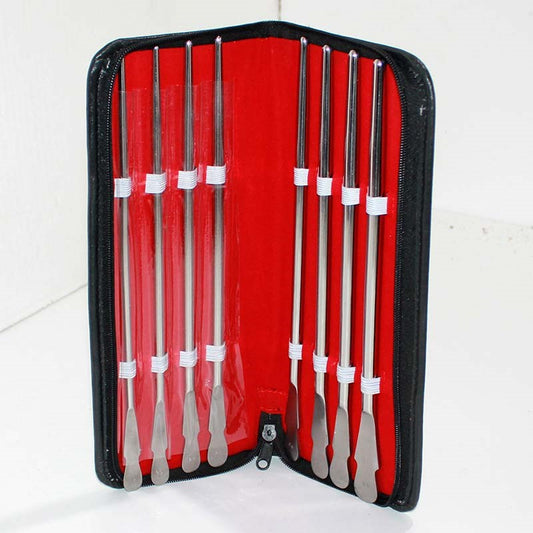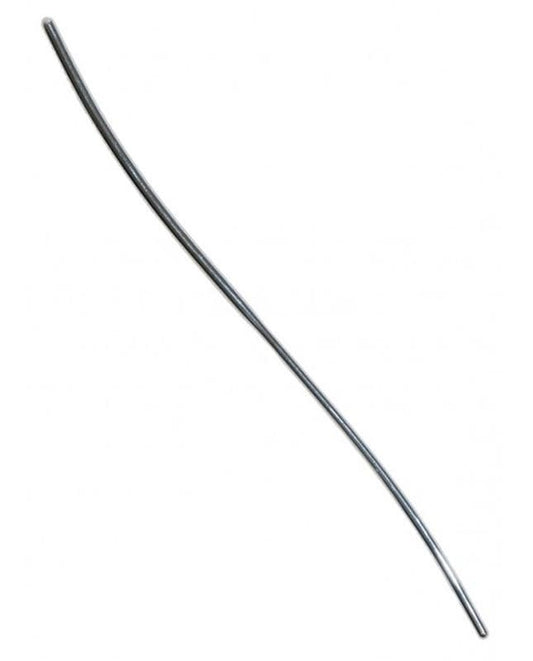-
BDStyle Van Buren Urethral Sound Set Medical Grade Steel J CurveSafety Meets SophisticationThe BDStyle Van Buren Urethral Sound Set represents the perfect fusion of medical-grade precision and thoughtful design elements. Each 10.5-inch sound is expertly crafted from premium stainless steel, featuring the distinctive J-shaped curve that has made Van Buren sounds a trusted choice...
- $129.99
- $129.99
- Unit price
- per
-
BDStyle Hegar Double Urethral Dilator Medical Grade Metal Sounding SetExperience Premium Medical-Grade PrecisionThe BDStyle Hegar Double Urethral Dilator combines professional-grade craftsmanship with thoughtful design to provide a superior urethral sounding experience. Each dilator is meticulously crafted from premium medical-grade metal, featuring a mirror-smooth polish that ensures maximum comfort and safety during use.Professional Design...
- from $59.99
- from $59.99
- Unit price
- per
-
Love In Leather 8 Piece Rosebud Dilator Sounding Kit Medical Grade SteelLove In Leather 8 Piece Rosebud Dilator Sounding Kit Love In Leather 8 Piece Rosebud Dilator Sounding Kit delivers comprehensive urethral exploration through precision-engineered stainless steel instruments that provide graduated progression for safe, controlled sounding experiences. This professional-grade kit represents the pinnacle of intimate...
- $94.99
- $94.99
- Unit price
- per
-
Love In Leather Hegar Dilator Sounding Sex Kit 8 Piece Medical GradeLove In Leather Hegar Dilator Sounding Sex Kit Love In Leather Hegar Dilator Sounding Sex Kit delivers comprehensive urethral exploration through its professional-grade collection of eight double-sided dilators that provide complete size progression from 3mm to 18mm, offering sophisticated practitioners the complete range needed...
- $69.99
- $69.99
- Unit price
- per
-
Dittle Urethral Sounding Kit Build Better BonersProduct Description Elevate your intimate exploration with the Dittle Urethral Sounding Kit from Hell's Couture. This expertly crafted set combines premium materials and thoughtful design to deliver a safe, exhilarating experience for those seeking to enhance their personal pleasure. Crafted from 100% non-magnetic, medical-grade...
- from $59.99
- from $59.99
- Unit price
- per
-
Medical Sex Flat End Urethral Sound KitExplore New Depths of Pleasure with the Medical Sex Flat End Urethral Sound Kit Embark on an extraordinary journey of sensual discovery with the Medical Sex Flat End Urethral Sound Kit. This comprehensive collection of 14 meticulously crafted sounds is designed for those who...
- from $54.99
- from $54.99
- Unit price
- per
-
Hegar Disposable Urethra DilatorExplore New Sensations with the Hegar Disposable Urethra Dilator Discover a new realm of intimate pleasure with the Hegar Disposable Urethra Dilator. This precision-engineered device combines medical-grade quality with thoughtful design, offering a safe and hygienic option for those interested in urethral play. Whether...
- $24.99
- $24.99
- Unit price
- per
-
BDStyle's Deluxe Urethral Play Sound Kit - Unleash Thrilling ExperiencesExplore New Depths of Pleasure with the Deluxe Flat Ended Sound Kit Embark on a journey of sensual discovery with the Deluxe Flat Ended Sound Kit. This premium collection of urethral sounds offers a versatile and exciting way to explore intimate stimulation, designed for...
- $89.99
- $89.99
- Unit price
- per
Frequently Asked Questions
How do I choose between Hegar, Pratt, or Dittle metal urethral sounds as a beginner?
Start with Hegar. The smooth tips and slow size steps help the glans and shaft adjust before trying longer tools like Pratt or Dittle.
Why do Pratt stainless urethral rods feel wider than Hegar even when they say the same size?
Pratt rods have a longer taper. The taper pushes deeper along the shaft, so the inside feels fuller than a short Hegar tip.
How do I know when deep-insertion urethral sounds are getting too close to the bladder?
Stop if you feel steady pressure. A sound should glide; pushing past the base of the shaft risks touching the bladder neck.
Can I use solid urethral sounding rods with my partner if I boil them first?
Yes, boiling clears surface germs. Dry the rods well so they slide cleanly into the urethral opening for each partner.
Why do I feel a tiny click when a classic metal sound for men passes near the prostate?
The curve inside the body can guide the rod against a ridge. Slow entry keeps the rod from knocking that area.
What’s the safest way to rotate stainless urethral rods so the curve doesn’t scrape the inner wall?
Hold them steady at the glans. Turn the rod slowly so the inside of the shaft stays in line with the curve.
Are double-ended Hegar rods harder to control than single-ended tools?
The unused end can wobble. Grip the centre to keep the rod still while entering the urethral opening.
Why does a rigid urethral rod for sounding dry with lube stuck in the size markings?
Etched marks can trap residue. Use warm water and a soft brush to clear the grooves before the next session.
Is it safe to lie flat on my back when using deep-insertion urethral sounds?
If the rod moves freely. Keep the shaft lifted so the rod follows the line of the urethra without bending.
Recently Viewed Products
Example product title
- $19.99
- $19.99
- Unit price
- per
Example product title
- $19.99
- $19.99
- Unit price
- per
Example product title
- $19.99
- $19.99
- Unit price
- per
Example product title
- $19.99
- $19.99
- Unit price
- per
Example product title
- $19.99
- $19.99
- Unit price
- per
Example product title
- $19.99
- $19.99
- Unit price
- per
Example product title
- $19.99
- $19.99
- Unit price
- per
Example product title
- $19.99
- $19.99
- Unit price
- per
Example product title
- $19.99
- $19.99
- Unit price
- per
Example product title
- $19.99
- $19.99
- Unit price
- per
Why Shop With Cock Ring Store?
- Choosing a selection results in a full page refresh.












